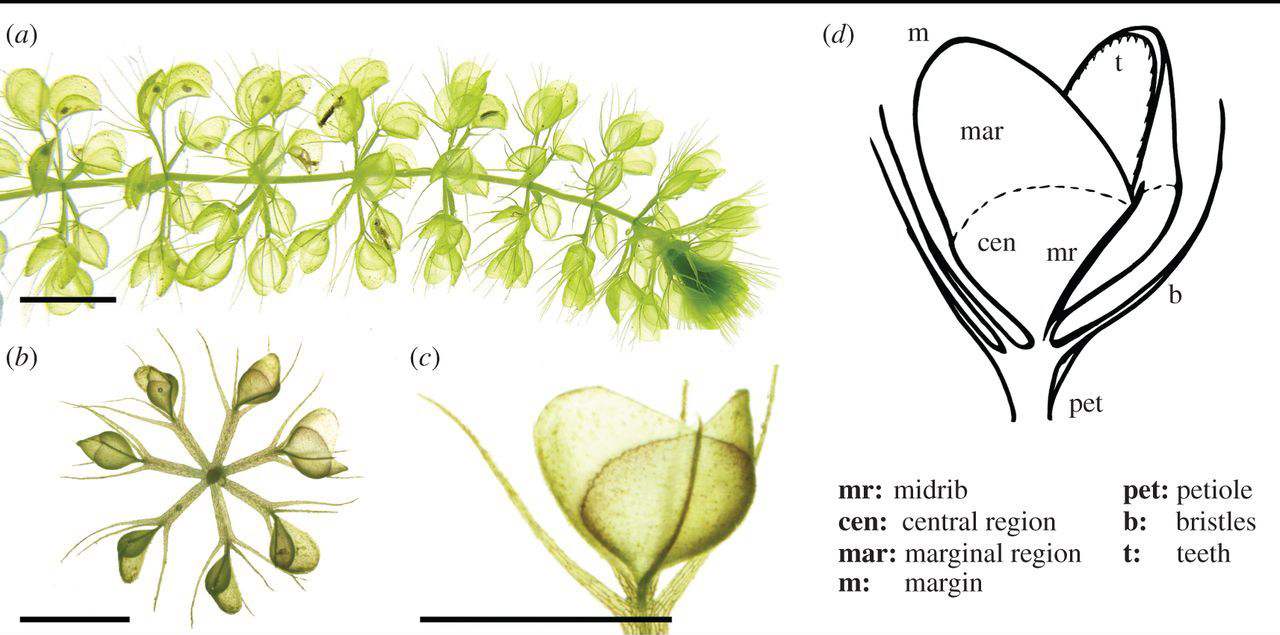Many habitats around the world are faced with the problem of invaders: exotic species that flourish in the new habitat, simultaneously destroying it and pushing out native species. Notable cases include the burmese python in the Everglades, which has decimated native species ranging from the 37 different bird species the pythons consume to white tailed deer (1, 4). Other examples include sea lampreys in the Great Lakes and bumblebees in Argentina. However, while all three of these species pose a huge ecological problem in the lands that they have invaded, they are disappearing in their native lands (1).
Aldrovanda vesiculosa, known colloquially as the waterwheel, faces a similar situation. Aldrovanda is a carnivorous aquatic plant native to wetlands in Australia, Africa, Asia and Europe that, due to the degradation and loss of wetland habitats, has been classified by the International Union for the Conservation of Nature as Endangered (2). However, after being introduced to the northeastern United States in the 90s from Japan by carnivorous plant growers, it has flourished, spreading from its introduction site of Virginia to New Jersey and New York (1).

Fig 1. Diagram showing different parts of Aldrovanda vesiculosa. Scale bars, 1 cm. (3)
Aldrovanda is limited in habitat by its carnivorous nature and, as a result, lives primarily in standing and slowly flowing freshwater. Naturally, it also prefers dystrophic environments, such as fishponds, lakes, and even shallow pools in sand pits (5). It is a free floating plant with shoots about 10 to 30 cms long with small leaf whorls containing traps that it uses to hunt (3). Similar to its relative Dionaea muscipula (better known as the Venus flytrap), it uses traps triggered by sensitive hairs to capture its prey. While Dionaea uses a quick release of elastic energy to snap its trap shut, Aldrovanda instead uses a combination of hydraulics and a release of internal stress that causes the midrib (the large vein in the middle of a leaf) to bend and the trap to close (3). Aldrovanda has a very diverse diet as well, consuming everything from insect larvae to even small fish (1).
Aldrovanda also serves as a classic example of the effect of human interference on habitats and their inhabitants. Its natural habitats are disappearing due to drainage, eutrophication from pollution, decline of water levels due to global warming, and general destruction due to recreation or the repurpose of a site (2,5). Aldrovanda is considered a stenotopic species, meaning that it’s only able to tolerate a limited range of conditions, and as a result of its habitat loss, over 90% of its habitat has vanished. It has gone extinct or is currently unverified in 32 countries (1,5). Due to its ‘Endangered’ classification, Aldrovanda has been protected in Australia, Japan, and its native European countries since 1982 (5). Thus, its presence in North America provides a bastion of hope for the small aquatic plant.
In the parts of the Northeast where Aldrovanda has become common, it has reached up to 1260 individuals per meter squared in its ideal optimal conditions (2) and has continued to spread, a drastic difference from its disappearance in its native habitats. Although naturalists fear that a large population of Aldrovanda could threaten native plant species and invertebrates, multiple studies, most recently by Dr. Cross, a researcher that studies Aldrovanda at Curtin University in Australia, and his team who looked at nine sites in Virginia, have concluded that Aldrovanda does not compete with native aquatic plants (2,5). Therefore, experts generally agree that Aldrovanda’s spread should be monitored, but that it should be left alone. After all, this may be one of the only ways to keep it alive.
References:
- Renault, M. (2019, August 13). This Carnivorous Plant Invaded New York. That May Be Its Only Hope. Retrieved from https://www.nytimes.com/2019/08/13/science/waterwheel-plants-carnivorous.html
- Cross, A. T., Skates, L. M., Adamec, L., Hammond, C. M., Sheridan, P. M., & Dixon, K. W. (2015). Population ecology of the endangered aquatic carnivorous macrophyte Aldrovanda vesiculosa at a naturalised site in North America. Freshwater Biology, 60(9), 1-12. doi:doi:10.1111/fwb.12609
- Westermeier, A. S., Sachse, R., Poppinga, S., Vögele, P., Adamec, L., Speck, T., & Bischoff, M. (2018). How the carnivorous waterwheel plant ( Aldrovanda vesiculosa ) snaps. Proceedings of the Royal Society B: Biological Sciences, 285(1878), 20180012. doi:10.1098/rspb.2018.0012
- Frazier, I. (2019, July). The Snakes That Ate Florida. Retrieved from https://www.smithsonianmag.com/science-nature/snakes-ate-florida-180972534/
- Adamec, L. (2018). Biological flora of Central Europe: Aldrovanda vesiculosa L. Perspectives in Plant Ecology, Evolution and Systematics, 35, 8-21. doi:10.1016/j.ppees.2018.10.001
